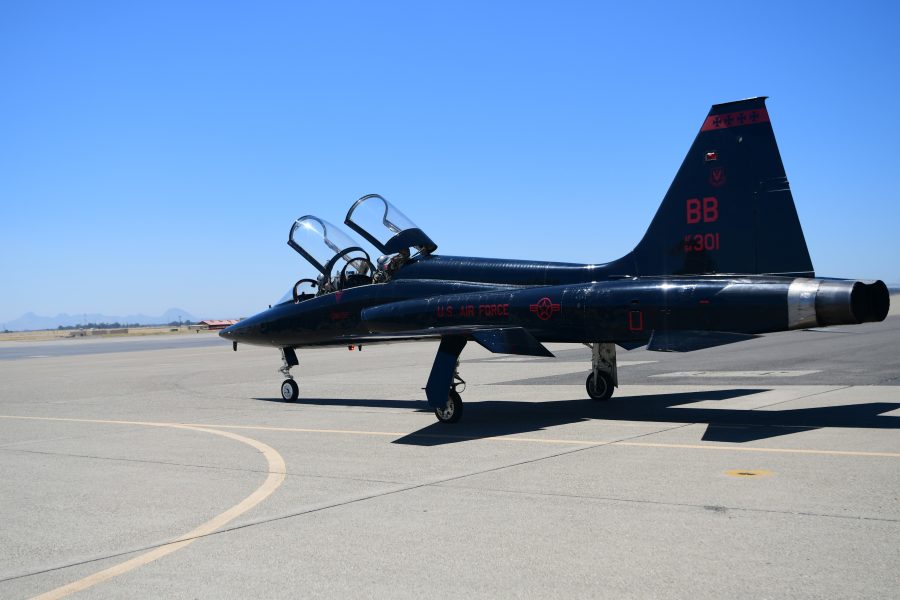While some future Air Force pilots wait for cockpits to open up so they can start training, they’re doing everything from public affairs to marshaling aircraft on the flight line, the head of the 19th Air Force said recently—highlighting the persistent problems the service faces in trying to reduce its pilot shortage.
As of Aug. 25, more than 900 Airmen are waiting to enter the pilot training pipeline, according to 19th Air Force data. Roughly a quarter have been waiting less than three months, but most are between three and nine months. Another quarter—around 220 people—have been stuck even longer.
“Wings will have these lieutenants that are waiting pilot training work in their PA shop,” Maj. Gen. Clark Quinn said during a briefing with reporters. “They will have them work in their command post, doing reporting. They will actually take some of them and teach them how to not necessarily do aircraft maintenance, but put them out on the flight line and marshal aircraft in and park, and get them connected to the mission. So they are kept gainfully employed unless they choose to take some leave and obviously take some time off.”
A spokesperson later added that future pilots also knock out their survival training while they wait. Some are assigned to earn postgraduate degrees.
The total number of those waiting is down slightly from a peak of more than 1,000, Quinn said. The Air Force is limited in part by the availability of its training aircraft, all of which entered service at least two decades ago.
The T-38 Talon, in particular, used to train future fighter and bomber pilots, is “frankly, struggling,” Quinn said. Production of the T-38 ended in 1972.
“The mission capable rates of the T-38 are not good,” Quinn added, noting that engine problems have forced the 19th Air Force to limit flying hours—and, in turn, prevented it from reaching its goal of producing 1,500 pilots per year.
The T-38 is not alone in experiencing issues, however. A batch of T-6 Texan IIs were damaged in a recent storm at Vance Air Force Base, Okla., Quinn said. And the service is in the process of retiring the T-1 Jayhawk, with aircraft already heading to the Boneyard at Davis-Monthan Air Force Base, Ariz.
Long term, the Air Force plans to replace the T-38 with the T-7 Red Hawk, an advanced new trainer currently undergoing flight testing. However, the Red Hawk has been delayed several times through development and is now not expected to reach initial operational capability until 2027.
There’s nothing Quinn can do to speed up the T-7’s schedule, but he said gaining it in the fleet will not only increase availability but also improve the overall training pipeline.
“[The T-38] a 60-plus-year old design that was designed for a type of aircraft that we haven’t flown in 30 years, and we spend a lot of time in training teaching young aviators how to do things that they don’t need in their next aircraft,” Quinn said.
In fiscal 2022, the Air Force produced 1,276 pilots. In 2023, that number increased slightly to around 1,350, but still short of the goal of 1,470. With demand from commercial airlines strong, the need for new pilots to replace those leaving the service is persistent. The 19th Air Force’s goal will be 1,500 new pilots in fiscal 2024, a spokesperson said.
Quinn said the overall pilot shortage remains at around 2,000, roughly the number it has been for the last several years. Vice Chief of Staff Gen. David W. Allvin previously told Congress that the Air Force has taken steps to ensure the shortfall doesn’t mean aircraft aren’t flying.
“In order to have a healthy pilot professional force, you need first and foremost the combat cockpits filled,” Allvin said in April. “Then you need the trainer cockpits filled. Then you need the test cockpits filled. And after you fill out the cockpits, then our next priority is the leadership—you want the leadership positions filled. And then after you have all those filled, then you go to the staff positions. That is where we are currently absorbing our shortage: in the staffs.”
Echoing Allvin, Quinn said that not filling staff positions has a long-term effect by stunting the “mentoring and growth of the officers that we expect to be able to lead our Air Force in the future.”
Pilots aren’t the only staffing shortfall—even the civilian flight instructors who teach future pilots on simulators are undermanned, Quinn said.
“We have openings at all of our locations. In some cases manning is down at the 60 to 70 percent level,” Quinn said. “What we ended up having to do is take military instructors to fill those civilian gaps and teach them and when you’re teaching the sims, you’re not teaching the flights.”
To address that problem, the 19th Air Force is trying to hire remote simulator instructors to entice civilians who don’t live near Air Force training centers. At the moment, though, Quinn’s team is working on a latency issue affecting that effort.
